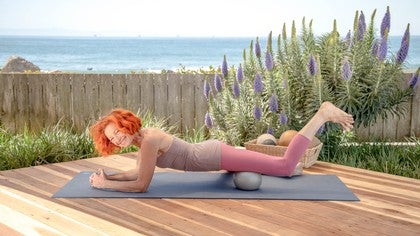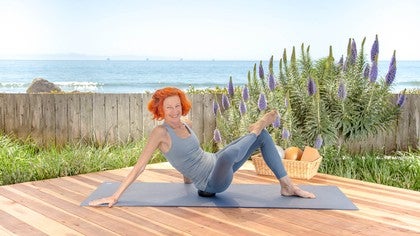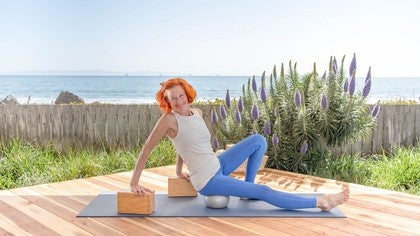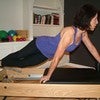Description
Props Needed: Silver Yamuna USA® Ball or a 5" Ball and 2 Yoga Blocks for extra support as the goal is to keep the low back supported and long.
About This Video
Transcript
Read Full Transcript
In this class, we're going to be focusing on the quads and unwinding the fascia and the quads. Those muscles that when you sit they're nice and tight. So you're in a chair in front of a computer and when you stand up, you kind of go, ooh, ooh, ooh, ooh. And they get chronically tight, chronically holding, and there's a few problems that you may or may not already experience. One is that you're just super grippy in here.
The other one that your pelvis is forward. You see people in this shape all the time. Most everybody's got the hips flung forward, nothing's working back here or these tight muscles are pulling your back tight. So now your back is holding your tension and you're basically not as comfortable as you could be. So we're gonna start rolling them out and starting to shift and free up some of this congestion that's built up inside the body.
So we will be going right from this bony area. Imagine drawing a line right down towards your knee. That's the general area of the map we're moving into. So come down onto the floor. So we will start.
I'm starting on my left side. We will be doing both sides and you want to find this bony part of your hip, and you will be laying that part of your body down on the ball. And once you're down here, check that the leg is nicely extended straight down if possible. And if you can hike the other hip up and check that you're not sinking into your lower back. So for some of you, this can be quite challenging just holding this position.
And we're going to be here for between five and 10 minutes. And you may want to take another ball, a pillow, a yoga block, and place it under your opposite hip just so you can focus in here rather than strain or shorten all the muscles which will happen if I relax my lower back. We want that back lengthening out. So we really get into what's tight. From this point, feel the weight digging into the bone, and now move a little bit further down.
So now you're in the area of the groin just below the bone. And as you're in this position, I will sometimes bend the opposite knee up to stabilize, and then see if you can bend this knee. And if you feel around a little bit, you'll feel the origin of the muscle. You'll actually feel where it begins because it gets nice and narrow and then it hooks up into that bone. So you want to find that part, sink into it, If it's tender, which you will find, you can start to do a little bit of micro movements in that area, because you're looking to break open and release some of the tightness it's building up in there and lengthen it.
So the fibers start to be long again, then drag yourself a little bit further forward and now you're right on top of your quad, the center part of the quad, rectus femoris, and it may feel like a lump and you want to get right into the slump. We're looking to relax it. Now, I just felt mine start to give up the ghost a little bit. Check to see that you're not falling off. Check to see that you're not sinking.
You want that muscle to be lengthened, and you want to think of it lengthening down in the direction of the knee, 'cause we want that shaft restored to its original length if you can. Really, you will pause here and until you can figure out how to allow that muscle to release, or you may have to repeat it a few times. As you're staying here, I'm adjusting my other leg. I'm slightly turning my knee out to roll across. It's kind of rolling over a lumpy area into another aspect of the quad, rolling back to the pinnacle of it and very slightly rolling out.
So we're crossing over a variety of muscle cords that can get very tight and knotted up and then come right back to that central shaft. You probably will feel it's a little bit softer. See if you can lift the leg up without relaxing into your lower back and soften even more, then stay in this nice deepen position and drag your body a little bit further forward to the ball rolls down and is going maybe 1/3 of the way down the quad. And you'll start the whole journey again. You want to let yourself soften into the muscle, check your lower back, see if you can get a sense of length and just allow the time to allow the tissue to start to shift because we're elastic.
Now, I am slowly rolling the knee outwards because the quad should be part of the rotation of the hip in the socket. I just went clunk, clunk, clunk, over a bunch of cords, tighter muscles, rolling back to the pinnacle. And then with the help of my hands, rotating a little bit further out, dragging the tissue of the muscle so it starts to de rigidify and unglue from all of those patterns. Breathing can help a lot. Taking a breath in and then breathing out and releasing.
We're going to move a little bit further down, we dragging through the muscles 2/3 of the way down. Now, while we're in this, if you're one of the people that it feels like you have a completely tight muscle, like it's like a cord or it's a rope, or it's like a mass that's not giving, you want to see if you can get more pillows under your chest and your waist so you can kind of pretend you're lying in your bed and really focus on that relaxing aspect. 'Cause you're sending the message to the muscle to stop being so tight. You're also sending the message to the muscle to lengthen down. So here we go, we turning out a little bit, rolling back to the middle, rotating a little bit further out and back to the middle.
Still sinking in very nicely. And then rolling just a little bit further forward. As you roll forward, you want to think of, am I getting as much links out of this muscle as I possibly can? Am I really lengthening it? And can I even bend the knee a little bit?
When the knee bend, you can feel the muscles start to lengthen even further. So you want to be opening up this very stretchy elastic aspect of the quad rather than the grippy tight surface of it. It should become even longer as you're rolling up and into it, really opening up the front of the quad. Oh, that's so nice. I can feel it's all of its connections into the knee, lengthening out even further.
Just felt the muscle release even further down. You're looking to get the muscles to soften so you can get literally towards the bone. And this can take more than once. And then one more time rolling all the way out to the top of the knee. Now, we're gonna repeat a segment of this one more time on the same leg, because the more times you do this, the more effective the release will be.
So back to the top. I'm sure all of you felt lumps, bumps, pain areas. We're looking for the pain. We're looking for the most tight congested part, and it's very intuitive. And you know now where your parts are, so let's drag forward and please find those areas that are talking to you and saying, here I am, this is what's holding.
This is where I need time. Find that spot, hang out here, pay attention to your breath, micro movements, to see if that's helping ease and stretch and open up that area that's just used to glowing, grip and hold. You can even talk to your muscles, check to see if you want to bend that knee a little bit. Now, I can really feel the muscles start to lengthen. So remember we're supposed to be elastic.
We're supposed to have this dance between the front and back of our bodies in relation to gravity. We're not supposed to be glued up and tight and stuck. And this brings back, it restores the power and it brings back this elastic interconnection between one body part and the other. If you had cords, when you were rolling out and rolling in, go for them. So find your spots and just settle into them and then drag yourself even further forward and come all the way up to the knee.
Just lengthen out and then come off and just for fun, lie down on your back for a minute, just check out what it feels like to have your legs long and see the difference and see what it feels like between the right and left side. Does this side feel different that you just worked? Does it feel longer? Does the hip flexor feel more open? Is the bone closer to the ground?
Just kind of check into that so that you can kind of grab what's happening. Notice the changes in your body and let's move on to the next side. So we have to even yourself out now. Remember, hip bone is your start point just as a location 'cause we get just below it. So place yourself on the ball.
I'm on my right side and just to review again, how you can prop yourself up, I'm using a yoga block now. So for some people, this is very stressful to be up on the elbows and maybe just having a block under the chest or a ball or a pillow can give a lot of support so then you can lengthen the muscle and not get all fatigued. The other option is literally putting something under your belly. Notice it actually, I'm gonna make it higher. If I have something right in the belly area, it keeps my lower back long and that's the goal.
We want this lower back nice and long because we're looking to have restore the ideal physiology, move towards it, free up the mutations that we've been developing with these muscles that keep tightening up and jamming us. So once you have that hip bone move down into the groin area, just below it and start again, lift the leg a bit, notice that if you can lift it, are you hiking into your lower back? Then that means there's a pull and just bend the knee a little bit a few times and you will feel all of that quad and how it connects in at the origin. So you just wanna get in touch with it. If you need to move around a little bit, that may feel really, really good to you.
And then drag yourself into the top shaft of the muscle. This is where it gets super grippy and then it writes down. So we want to remember, we want to soften this muscle. I'll tell you a nice story. As we sit here and we soften, a client came to me with two years of hip pain and seen lots of experts and really in a lot of pain to say the least.
And this routine was one of the routines we did. In an hour and a half we did three different routines. She stood up and she was like, I can't believe it. I don't have pain. I can't believe it.
I have not had pain in two years and I've been told I need surgery and all this stuff. She was so freaked out by the change in her body. And I'm telling you this because it can be like a miracle. My muscle just gave up and just opened. It can be really, really wonderful to release these knots because suddenly you remember a way of being that you probably forgot you were and we want it back.
So here we go, rolling my knee out a little bit into the inner part of the shaft of the rectus femoris, for the quad, just feeling that pool of the muscle, riding back to the pinnacle of the muscle, where it gets really tight and holding, and then rolling a little bit to the outside and back again. Just there, right there. If you want to lift up without sagging do so, it's up to you. Stay in the top part of the muscle and then roll a little bit further forward. Again, remember this is quite intuitive.
No two people are the same and where you're not adapt is your unique creation and you feel free to move around in those ways that are serving your body. If you feel inclined to right here, this inch is where I need the pressure. Trust it, it will give you the goal. So here I am. I'm rolling out a bit.
Back to the top. Very slowly rolling in and back to the top. Check to see that you're sinking in. Check to see that you're breathing. Check to see the alignment.
Just kind of take time here. Each one of these routines, minimum two minutes, five minutes, 10 minutes. It's worth the time because it changes so, so profound in the body. Roll a little bit further forward. So now I would say I'm 2/3 of the way down my quad.
I am letting the muscle soften the texture of a healthy muscle should be soft. Think of a cat, you know, a cat they have this elastic skin and muscle structure. They're not knotted up and tight. They're always so able to relax and yet when they see a bird or mouse, so they want to jump, they have power and the power isn't being wasted by being tight. Us humans have that kind of power too, but we kind of lost the skill and we've developed a life of too much comfort, too much sitting, too much cushions, too much lack of movement and we just kind of forgot, but we can remember.
So here we are, nice soft muscle, rollout a little bit. Ah, just felt something really elongate, back to the center. Each one of these spots, if you feel you need to visit it, go there, stay there a little bit longer. This is just setting you up so you know how to do this for yourself. So right here, I'm feeling inclined to add a prop.
Yes, and here we go. So again, this is an intuitive process. The prop allows me to get even more pressure into this ball. And by the way, as you get more adept at this work, you will find different balls serve you better, stronger balls, smaller balls. It's not like use this ball and you will have a miracle.
No, your body is designed to adapt to so many different environments and providing lots of different stimulation, wakes up the intelligence of the body. But we start with a ball that we can endure and is not so aggressive into the texture of the muscle that we'd feel abused. We want to enhance and in time the intensity of the work will deepen. I am now rolling further forward, further forward, further forward. So I'm right close to the knee, lengthening out.
The other block is just not giving me the support to put all the weight on the ball and create the length that I want into this muscle shaft. Oh, that feels so good. And here we go, pressing back and we'll do one more visit down the shaft. Remember, it's your body, you know where the pain is. So find it, go visit those areas that are uncomfortable and tighten just below the surface in your daily life.
You think it's your hip flexors. It's just the tip of the iceberg. And just for fun, I'm going to add a block on the other hip. And it's a little higher than the hip of the ball, which means I'm using it to really throw the weight into the ball right into the area that's real tight for me so you can play with these things. Now, check that you're not collapsed in the lower back.
Remember, we are looking to open the hip flexor and if your quad really releases, you will feel the glute and the hamstring slightly kick in 'cause something's got to hold the leg up. This should be the dance between the front and back of the body, not the lower back and the quad dominant gain that most of us are involved with. So find your sweet spot. I'm gonna take the block off so I can move further forward. Just drag out that muscle in whatever way you want, whatever feels good.
Make sure it's getting longer. Check the relationship from its origin in relation to the pelvis. You're sculpting your body right now. Lengthen it even further and just roll all the way out. Take your time.
You want to really iron out the muscle until you get to the knee. Nice long lean quad, that's powerful, and will do you well in walking, running, and life. So please come off and guess what? Lie down on your back. Just feel what's happening.
So lying down. Let's check and see. Do you feel more open? Both legs feel amazing in my body. How do your quads feel?
Do you feel that the legs longer? Do you feel the bones are more close to the ground? Possibly even more balanced in your hips? Possibly not. It's not like one muscle fixes everything, but just enjoy the feeling.
So now let's see how these wonderful legs of ours feel when we come up. So bring yourselves up. I'm not sure if you're able to squat. If those muscles are really tight, it's out of the question, but eventually you wanna be able to have this position, but get yourself up, actually just stand. First of all, just stand, see what the legs feel like, see how the hip flexors feel and just imagine yourself in a chair and then can you feel more open here?
And the other big question is, are you as far forward as you were before, because you don't wanna live here. This is not good news for the hips or the quads. You need to bring the hips back enough that you actually start to activate the back chain of the body, but I hope you feel better and just take a few steps and see what it feels like to walk. Are the legs a little bit more free? Do you feel more graceful on your legs?
Is there more freedom? Enjoy, notice how you feel the rest of the day. Notice how you feel tomorrow and let me know in the comments.
Release Your Fascia: with Niedra Gabriel
Comments
You need to be a subscriber to post a comment.
Please Log In or Create an Account to start your free trial.



















